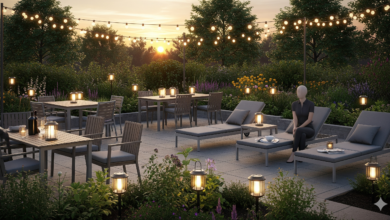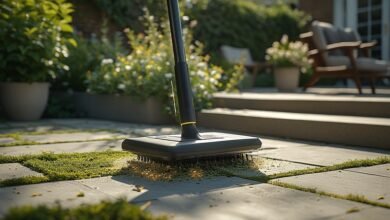Self-Watering & Vertical Gardening Kits: The Future of Urban Gardening
Gardening in 2025 is no longer limited to sprawling backyards or rural spaces. Urban dwellers and plant enthusiasts are embracing self-watering and vertical gardening kits, which bring greenery to apartments, balconies, and small patios. These innovative solutions combine space efficiency, sustainability, and smart watering technology, making gardening accessible, convenient, and environmentally friendly.
Self-Watering Gardening Kits: Smart Hydration for Healthy Plants 💧🌿
Self-watering kits are designed to maintain optimal soil moisture, reducing the need for daily watering while promoting healthy plant growth.
- Trend Appeal: Perfect for busy urbanites, forgetful gardeners, or anyone seeking low-maintenance greenery.
- Popular Features: Built-in water reservoirs, wicking systems, and moisture indicators that prevent overwatering or drought stress.
- Plant Compatibility: Suitable for herbs, vegetables, succulents, and indoor plants.
Why They’re Trending 🌟
In 2025, sustainability and convenience are key. Self-watering kits save water and time, supporting eco-conscious lifestyles. They also appeal to tech-savvy consumers who enjoy integrating smart sensors and app notifications to monitor plant health.
Strengths & Limitations ⚖️
- ✅ Strengths: Low-maintenance, water-efficient, ideal for busy schedules
- ❌ Limitations: May require initial setup, limited capacity for larger plants
Vertical Gardening Kits: Maximizing Space & Aesthetics 🌿🏢
Vertical gardening kits allow plants to grow upward rather than outward, making them ideal for small apartments, balconies, and urban terraces.
- Trend Appeal: Combines functionality with décor, creating lush green walls that improve air quality and aesthetics.
- Popular Features: Modular panels, stackable planters, wall-mounted pockets, and hydroponic options for soil-less growth.
- Plant Compatibility: Herbs, leafy greens, trailing vines, and ornamental plants thrive in vertical setups.
Why They’re Trending 🌟
Urban gardening is no longer just about growing food—it’s about bringing nature indoors. Vertical gardens save space, reduce clutter, and provide therapeutic greenery, supporting mental health and well-being.
Strengths & Limitations ⚖️
- ✅ Strengths: Space-efficient, decorative, supports multiple plant varieties
- ❌ Limitations: Requires sturdy support and regular maintenance for optimal growth
Comparison: Self-Watering vs. Vertical Kits ⚖️
- Purpose: Self-watering kits prioritize water management and plant health, while vertical kits focus on space optimization and aesthetics.
- Ease of Use: Self-watering kits are highly automated, reducing daily maintenance. Vertical kits may require more regular care depending on plant type.
- Best Use Case: Urban apartments benefit from vertical modular setups, while busy households enjoy self-watering kits for effortless greenery.
👉 Many gardeners combine both: vertical structures with self-watering capabilities, merging the best of convenience and design.
Market Trends Driving Popularity 📈🌱
- Urbanization & Limited Space: As more people live in apartments, compact gardening solutions are increasingly necessary.
- Sustainability & Water Conservation: Kits that reduce water use align with eco-conscious consumer values.
- DIY & Smart Integration: Smart sensors, apps, and modular systems enable personalized and monitored plant care.
- Health & Wellbeing: Indoor greenery improves air quality, reduces stress, and promotes mental wellness.
Trend Drivers 🌟
- Social media influence and home décor trends
- Rise of indoor gardening enthusiasts
- Increased focus on homegrown herbs and vegetables
Design & Usability Innovations 🎨💡
Modern kits are stylish, compact, and customizable. Features include:
- Smart Sensors: Track soil moisture, temperature, and sunlight exposure.
- Modular Panels: Expandable vertical systems for growing multiple plants in limited space.
- Eco-Friendly Materials: Sustainable plastics, bamboo, and recycled composites are common.
- Integrated Lighting: LED grow lights support indoor plant growth regardless of natural light availability.
Strengths & Limitations ⚖️
- Strengths:
✅ Space-saving and adaptable to small urban homes
✅ Water-efficient and low-maintenance options
✅ Aesthetic appeal enhances indoor and balcony environments
✅ Supports a variety of plant types - Limitations:
❌ Vertical kits require careful placement for sunlight
❌ Self-watering reservoirs need periodic cleaning
❌ Some advanced kits are relatively expensive
Final Verdict 🏆
Self-watering and vertical gardening kits are transforming the way people grow plants in urban settings. They provide:
- Convenience: Low-maintenance watering and modular design save time and effort.
- Sustainability: Water-efficient systems and eco-friendly materials reduce environmental impact.
- Lifestyle Benefits: Indoor greenery improves air quality, boosts mental well-being, and elevates home aesthetics.
In 2025, these kits are essential for modern gardeners, combining technology, design, and sustainability to make gardening accessible, beautiful, and stress-free. 🌱🏢💧



